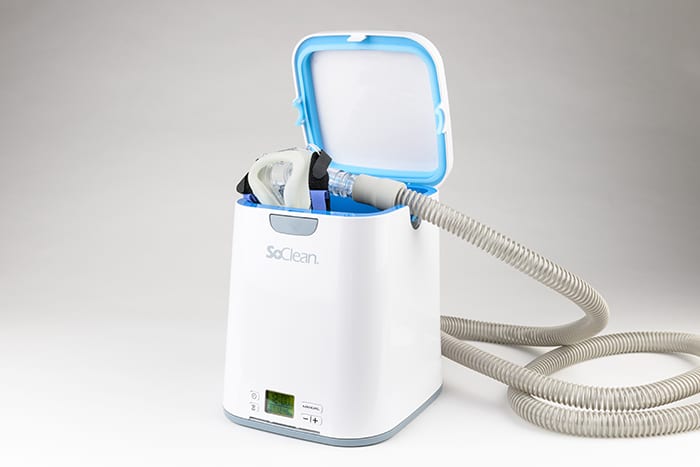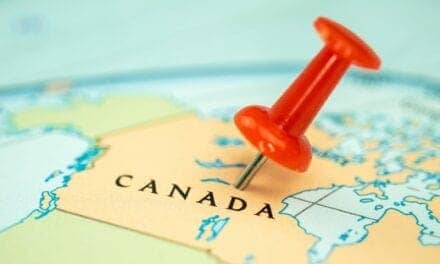Amid scrutiny over CPAP cleaning devices, including legal disputes and FDA warnings, the industry sees a movement back to manual cleaning methods.
By Alyx Arnett
For CPAP users, automated cleaning devices have promised a convenient maintenance shortcut. However, the allure of these CPAP cleaners may be waning due to growing safety concerns, high-profile legal disputes, better education, and warranty clarifications.
The reassessment of these cleaning methods stems from years of scrutiny directed at ozone and ultraviolet (UV) light-based CPAP cleaners for their potential risks. A US Food and Drug Administration (FDA) press announcement issued in 2020 reminded patients that these devices are not FDA authorized and highlighted reports of injuries associated with ozone cleaners, including breathing difficulties, and cautioned against burns and other risks posed by certain UV cleaners.1
The situation escalated following Philips Respironics’ June 2021 recall of certain CPAPs, BiPAPs, and ventilators, in which Philips accused SoClean, a manufacturer of ozone-based cleaners, of contributing to the degradation of CPAP devices. In response, SoClean sued Philips for “false and misleading statements” and claimed that placing the blame on SoClean was an attempt to “divert attention away from obvious design flaws.”
In January, Philips countersued SoClean for marketing its ozone cleaners as compatible with Philips’ CPAPs and BiPAPs, despite SoClean allegedly being aware that ozone could deteriorate the polyester-based polyurethane (PE-PUR) foam used for noise reduction in some Philips devices.
SoClean recalled its SoClean2 and SoClean3 devices late last year due to 7,417 complaints “resulting from improper set-up, unauthorized device modifications, and use by individuals for whom the device is not recommended as indicated in the user manual.”
According to some industry experts, this negative press has led to a shift away from automated CPAP cleaners and back to basic cleaning practices. “People are figuring out that using ozone and UV light are extremely harmful to people, their environment, and their equipment. And manufacturers have come out and officially said, ‘You can’t use these things with our stuff,’” says David Kasso, RCP, RPSGT, co-owner at Siestamed Technologies, maker of a CPAP supplies dryer. “It’s brought people back to the fact that the only thing their manufacturer recommends is soap and water and drying your stuff out.”
What’s the Issue With Ozone?

The Environmental Protection Agency (EPA) has warned that, when inhaled, ozone can damage the lungs, worsen chronic respiratory diseases, or increase the chance of respiratory infection.2 “Relatively low amounts” can cause chest pain, coughing, shortness of breath, and throat irritation.2
The FDA has noted that ozone can leak from ozone-based CPAP cleaners at tubing connections, filters, or through containers used to house CPAP accessories, which may cause a temporary rise to unsafe levels. The FDA also has cautioned that using a CPAP immediately after an ozone-based cleaning, without airing out the system, could lead to inhalation of residual gas.
“Recovery from the harmful effects can occur following short-term exposure to low levels of ozone, but health effects may become more damaging and recovery less certain at higher levels or from longer exposures,” according to the EPA’s website.
Philips also claims ozone causes materials—such as the PE-PUR foam in its recalled CPAP and BiPAP machines—to degrade. Philips’ investigations found that devices whose users reported cleaning them with ozone were 17 times more likely to have significant visual foam degradation or volume reduction than those with no reported ozone use.
This is noted in Philips’ countersuit against SoClean, and Philips has instructed patients to follow the recommended cleaning and replacement guidelines and not use ozone and UV light cleaning products.
What’s the Issue With UV?
In its 2020 press announcement, the FDA reported that it had not received any adverse event reports for UV light products claiming to clean, disinfect, or sanitize CPAP devices and accessories.
However, it cautioned that UV light-based products could cause burns, eye damage, or increase the risk of skin cancer, depending on wavelength, intensity, and exposure time.
The FDA further noted that its studies found significant variations in UV light intensity and exposure duration across different UV-based cleaners. If the UV light is too weak or the exposure time too brief, CPAP masks and accessories may not be properly disinfected, potentially resulting in safety and performance concerns. The FDA also noted that UV light may not be able to penetrate all CPAP components, again leading to inadequate disinfection.
There are two types of UV devices, according to Jim Gilkison, vice president of sales at LiViliti Health Products, which makes a UV-based sanitizer that it hopes to get FDA authorized. “There’s LED, which is what we do, and then [others] are using a quartz bulb. There’s a big difference in temperature,” he says. “Those with quartz bulbs, you’ll get smell like a tanning bed, and you can burn foam with those. You can have masks that turn color.”
Patient Reeducation

With a spotlight on CPAP cleaners, more patients have become aware of a significant misconception about the devices: They aren’t intended to replace manufacturers’ guidelines for manual cleaning. The user manual for SoClean 2 states that it “should be used as a supplement to your cleaning routine, not a replacement.” Users are instructed to wash, rinse, and dry the hose and mask first.
Michelle Worley, RN, director of clinical operations at Aeroflow Sleep, a provider of CPAP equipment and supplies, says, “It will not remove dirt and debris.”
The FDA has previously stated that it does not have evidence of whether CPAP cleaning devices work to clean or disinfect CPAP equipment of germs or allergens.3
Worley says Aeroflow Sleep does not recommend CPAP cleaners to patients. Instead, patients are advised to wash their CPAP equipment in mild soap and water to prevent the build-up of bacteria and deterioration of materials.
Despite the confusion and potential health risks associated with CPAP cleaners, Gilkison says that patients are ultimately benefiting from the increased scrutiny of these devices. “Patients have won because they’re getting a better education about what these devices do and what they don’t do and what’s really important. And that’s being compliant with the CPAP manufacturers’ guidelines,” he says.
Some CPAP users, who previously did not clean their supplies, also have come to realize the importance of regular cleaning. “It has brought presence of mind to patients, and they realize, ‘Hey, this stuff does need to be cleaned. This stuff needs to be kept up with and washed,’” says Kasso.
A 2017 study of 137 patients with obstructive sleep apnea reported that 38% of patients using CPAP did not wash the mask, and 83% did not wash the tubing.4
“I always tell people, ‘If you wouldn’t drink a glass of water out of it, why would you put it on your face for eight hours?’” says Gilkison.
The Rise of Alternatives

Concerns over certain CPAP cleaners have prompted some patients to explore alternative devices or cleaning methods, according to Sam Martinez, co-owner of Siestamed. It has also motivated those who previously neglected to clean their devices to begin searching for safe and effective cleaning solutions.
As a result, sales for Siestamed’s Hurricane CPAP Equipment Dryer, which has been on the market for 12 years, have exploded. Sales went from around 25 to 30 units a month in 2020 to over 400 a month currently.
“Our campaign from the very beginning was to look at the gold standard of cleaning, and it’s soap, water, and dry,” says Martinez.
The Hurricane dryer uses static air to dry CPAP equipment, offering automatic shut-off and temperature control (below 121 degrees Fahrenheit). It comes with three timer settings (15, 30, and 60 minutes) to accommodate different drying needs and includes two ports for drying CPAP hoses. Martinez says the number-one complaint people have when washing their CPAP equipment is that they can’t get their tubing dry. “The Hurricane does just that, and it does it in a timely fashion,” he says.

New to the market, LiViliti Health Products launched CPAP pads and concentrated soap this year. The pads are recommended for daily use on the mask, while the soap can be used for a weekly deep clean of the hose and water chamber.
“The home care dealers can talk about using CPAP soap or similar products to get patients in a better habit of keeping their stuff clean. All that goes to the big word, which is compliance. That’s what the aim of providers in their business is: to keep us compliant because then they can bill for their patients,” says Gilkison.
The Fall of CPAP Cleaners?
Monica Mallampalli, PhD, executive director of the patient advocacy group Alliance of Sleep Apnea Partners, says she believes there is an increased awareness among patients about the CPAP manufacturers who have stated that using ozone cleaners will void the limited warranty on repairs and damages.
For example, ResMed states on its website that its limited warranty will not cover ozone damage caused to ResMed devices sold to patients on or after Feb. 1, 2020. The company notes that it can determine if a device has been damaged by ozone from a visual inspection of the interior.
“Our advice would be to follow manufacturers’ instructions. Stay away from cleaning devices, and refer to the instruction manual for the device or website for cleaning instructions,” Mallampalli says.
SoClean did not respond to requests for comment.
References
- FDA news release. FDA reminds patients that devices claiming to clean, disinfect or sanitize CPAP machines using ozone gas or UV light have not been FDA authorized. 2020 Feb 27. Available at https://www.fda.gov/news-events/press-announcements/fda-reminds-patients-devices-claiming-clean-disinfect-or-sanitize-cpap-machines-using-ozone-gas-or.
- United States Environmental Protection Agency. Ozone generators that are sold as air cleaners. Updated 2023 June 27. Available at https://www.epa.gov/indoor-air-quality-iaq/ozone-generators-are-sold-air-cleaners.
- FDA consumer update. CPAP machine cleaning: ozone, UV light products are not FDA approved. Updated 2023 Oct 6. Available at https://www.fda.gov/consumers/consumer-updates/cpap-machine-cleaning-ozone-uv-light-products-are-not-fda-approved.
- Mercieca L, Pullicino R, Camilleri K, et al. Continuous positive airway pressure: is it a route for infection in those with obstructive sleep apnoea? Sleep Sci. 2017;10(1):28-34.
Photo 162033222 © Andrii Zastrozhnov | Dreamstime.com





